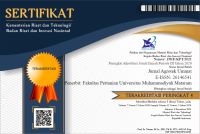RANCANG BANGUN DAN UJI KINERJA SISTEM KONTROL FERTIGASI DENGAN IRIGASI TETES
Abstract
Kebutuhan nutrisi pada tanaman dalam bentuk unsur hara baik yang berasal dari tanah itu sendiri dan dari luar dalam bentuk pupuk mempengaruhi produktifitas tanaman.Komposisi dan kualitas tanah yang bervariasi berperan pada kesuburan tanaman sehingga diperlukan pengaturan dan pengontrolandalam memformulasikan pupuk yang optimal serta penjadwalan pemberian nutrisi bagi tanaman.Penerapan mikrokontroler pada sistem fertigasi dapat memungkinkan dalam mengontrol pemberian unsur hara secara otomatis berdasarkan perintah.Penerapan sistem fertigasi berbasis mikrokontroler dalam budidaya sayuran diharapkan dapat meningkatkan produktivitasnya dan dapat mengurangi penggunaan unsur hara yang berlebihan sehingga biaya dalam budidaya tanaman dapat ditekan serta untuk efisiensi tenaga kerja dan menghemat biaya.Penelitian ini bertujuan untuk merancang sistem fertigasi otomatis dengan acuan kendali On/Off pada kran otomatis solenoid valve, melakukan pengujian volume dan waktu pemberian fertigasi dengan irigasi tetes, danmenentukan formulasi larutan unsur hara sesuai dengan kebutuhan tanaman.Selama simulasi diasumsikan pada tanaman bayam yang harus diketahui terlebih dahulu jumlah kebutuhan air tanamannya dan kebutuhan nutrisi selama satu periode umur tanam. Metode yang digunakan dalam penelitian ini adalah metode eksperimental dengan penelitian langsung di laboratorium. Penelitian ini dilakukan di laboratorium Teknik dan Konservasi Lingkungan Pertanian dengan parameter yang diamati adalah debit emitter,koefisien keseragaman tetesan, Larutan AB mix dan penggunaan air, dan kinerja sistem kendali On/Off fertigasi sesuai dengan umur tanam dan kebutuhan tanaman.Dari hasil pengamatan, uji kinerja sistem kontrol bekerja dengan baik dengan melakukan setting point waktu sesuai yang diinginkan. Didapat sistem yang sangat baik untuk digunakan dengan rata-rata koefisien keseragaman irigasi CU sebesar 96,50% dan debit aliran penetes yang cukup stabil pada setiap perlakuan waktu dan volume; didapat kisaran debit 0,000140 l/detik – 0,000150 l/detik.
The form of nutrients both derived from the soil itself and from outside, in the form of fertilizer, affect the productivity of plant. The various composition and quality of soil has role on plant fertily, therefore regulation and control in formulating optimal fertilizer and scheduling of nutrition for the plant were necessary. The aplication of microcontroller to the fertigation system might be possible in controlling nutrient delivery automatically usingdesigned command language. The aplication of microcontroller based fertilization system in plant cultivationis exected to increase the yieldand decrease the excessive use of nutrients, so that the cost could be supressed as well as labor efficiency and cost saving. The aim of this research was to design automatic fertigation system with on/off system referenceof automatic solenoid valve, testing the fertigation volume and time with drip irrigation and determine nutrient solution formulation according to plant requirement. During the simulation, it was assumed that the amount of crop water requirement and nutritional needs for spinach planting period must be determined in advance.The metode used in this study was experimental method with direct research in the laboratory. This research was conducted in Laboratory of Agricultural EnviromentEngineering and Conservation with parameters observed were emitter discharge, drip uniformitycoefficient,AB mixed solution and water used, and performance of the On/Off fertigation control system correspond with plant age and requirement. The observation showed that the control sytem worked well by applying the desired setting point. The coefficient of uniformity CU was 96.50% and the drip flow rate were relatively stable on each time and volume treatment; the discharge range was 0.000140 l/s – 0.000150 l/s.Keywords
Full Text:
PDFDOI: https://doi.org/10.31764/agrotek.v5i1.236
Refbacks
- There are currently no refbacks.
Copyright (c) 2018 Author(s)

 |  |  |  |
| |||
 |  |  |
|
Alamat Kantor












